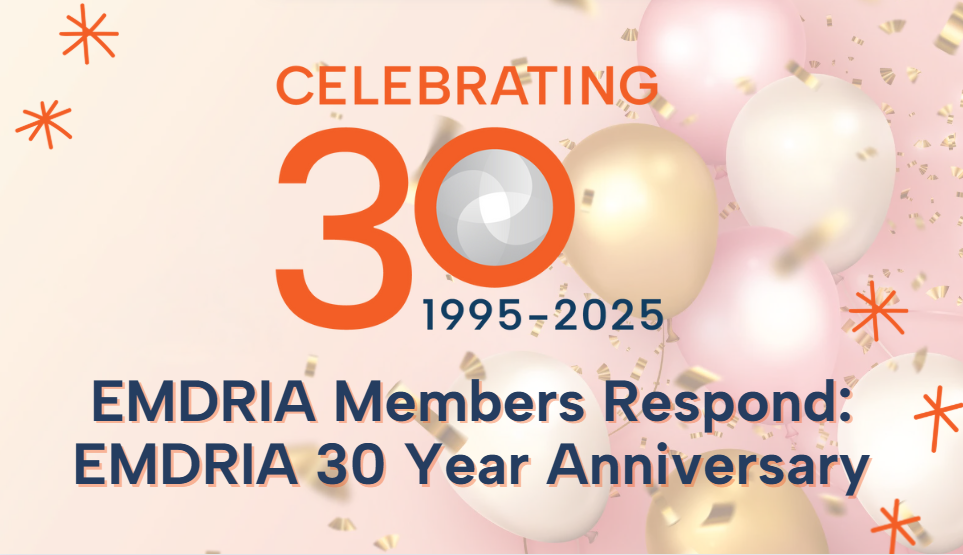In the News
Celebrities are name-dropping EMDR therapy, causing more interest in the treatment, according to The New York Post article “80% Spike in Bookings for Treatment Used by ‘Secret Lives of Mormon Wives’ Star, Prince Harry and Miley Cyrus.”
EMDRIA member Dr. Monique Thompson is interviewed about working with couples and EMDR as a trauma treatment for both individuals and couples in Dr. Dabach’s podcast Relationship Revival. Episode “Trauma, Infidelity, and EMDR in Couples Therapy”
EMDR therapy’s mechanisms of action are in the spotlight again in this Spatial Cognition blog “EMDR and Posner Paradigm: Innovative Approaches to Reprocessing Negative Memories” which discussed recent research published by Frontiers in Psychiatry (Piccardi et al., 2025), which investigated attention shifting as a critical role in the therapeutic process.
In this Newsweek article “I Kept Waking Up in Sheer Panic – It Had Nothing To Do With Nightmares.” recounting a personal experience with panic attacks, EMDRIA member Lauren Borkowski, LPC, shares how EMDR therapy helps to regulate the nervous system to resolve panic episodes as well as treat traumatic memories.
The Buckeye Flame reports that EMDR therapy is part of a “whole person” approach to treat trauma, sexual and mental health together in “‘You Matter. Period.’ Inside an Ohio Clinic Making Sexual and Mental Health Work Together for LGBTQ+ Patients.”
EMDRIA members Dr. Anka Roberto and Briana Carr, LCSW are featured on the University of North Carolina Wilmington’s College of Health & Human Services description of EMDR therapy as trauma-informed care in “Healing Trauma Through EMDR Therapy.”
EMDR therapy is mentioned as a way to achieve Post Traumatic Growth for people in the military and veteran communities in RealClearDefense article “Post Traumatic Growth: The Other Side of Trauma.”
EMDRIA member Leah Danley, LPC is featured in Oklahoma’s Own 9 news report “Oklahoma Therapist Reveals Effective Trauma Treatment Options and How to Seek Help.” Danley discusses common signs of trauma as well as how EMDR therapy can help.
EMDR therapy is mentioned as treatment of choice for those considering pregnancy after losing a child in Pulitzer Center story article “I Was Terrified’: Services Help meet Mental Health Needs During Pregnancy After Stillbirth.”
EMDRIA member and trainer Kelly Smyth-Dent, LCSW discusses EMDR therapy in WGLT news report “McLean County Invests in Eye Movement and Memory Therapy Training for Counselors and Social Workers.” In addition, the central Illinois county’s director of behavioral health coordinator, Marita Landreth, discusses the “pretty significant impact” for the region – more than a quarter of the licensed social workers and professional counselors in the county received EMDR training from this county-allocated funding.
The Ministry of Defense of the Republic of Azerbaijan press brief reports that EMDR therapy information is provided to military psychologists as part of a program “to enhance the knowledge, skills, and professional level of psychologists serving in the Azerbaijan Army” in “Azerbaijan Army Holds a Training Program for Psychologists.”
EMDRIA member Dr. Isabelle Gaffney and Dr. Chua Sook Ning discuss the purpose, applications of EMDR, and what clients can expect in the therapy room in this Being Human podcast episode “Let’s Talk About EMDR.”
Almost $100,000 in funding has been awarded for EMDR training in Montgomery County, PA as PA House news release “Scott: Montgomery County Receives Over $2 million to Fund Crisis, Addiction, and Victim Support Programs” states.
EMDR therapy is one of the PTSD treatments listed for folks who exprience trauma symptoms from witnessing violence in MedicalXPress article “If You Witnessed the Bondi Hanukkah Attack, Here’s What You Might Be Going Through.“
EMDR research on the horizon: Zentralinstitut für Seelische Gesundheitt published news release “Stress Intensifies Pain and Makes it Harder to Regulate Emotions in Cases of Depression and Fibromyalgia” sharing recent research and stating “The study demonstrates the high relevance of psychotherapeutic methods that specifically target improving emotion and stress regulation. Such approaches could further improve treatment for both chronic pain and depression. Building on the latest findings, a follow-up study is now being launched to test an innovative brief intervention for stress reduction. The method is based on EMDR (Eye Movement Desensitization and Reprocessing) and uses eye-guided desensitization to reduce emotional stress more quickly. The aim is to examine whether this can specifically influence dysregulation in the brain and break the vicious cycle of pain and stress in the long term.”
Bachelor Nation star Krystal Nielson reveals EMDR therapy helped her build resilience to recover from a traumatic birth experience in Bachelor Nation article here.
Back to Focal Point Blog Homepage
Additional Resources
If you are a therapist interested in the EMDR training:
- Learn more about EMDR therapy at the EMDRIA Library
- Learn more about EMDR Training
- Search for an EMDR Training Provider
- Check out our EMDR Training FAQ
If you are EMDR trained:
- Check out the EMDRIA Let’s Talk EMDR Podcast
- Check out the EMDRIA Focal Point Blog
- Learn more about EMDRIA membership
- Search for EMDR Continuing Education opportunities
If you are an EMDRIA™ Member:
Date
December 26, 2025





